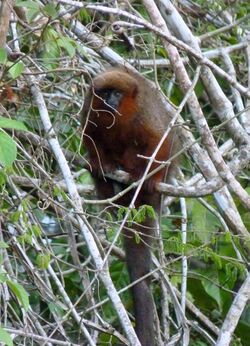Biology:Madidi titi monkey
| Madidi titi | |
|---|---|

| |
| Scientific classification | |
| Domain: | Eukaryota |
| Kingdom: | Animalia |
| Phylum: | Chordata |
| Class: | Mammalia |
| Order: | Primates |
| Suborder: | Haplorhini |
| Infraorder: | Simiiformes |
| Family: | Pitheciidae |
| Genus: | Plecturocebus |
| Species: | P. aureipalatii
|
| Binomial name | |
| Plecturocebus aureipalatii (Wallace, Gómez, A. M. Felton, & A. Felton, 2006)[2]
| |
| Synonyms | |
|
Callicebus aureipalatii Wallace, Gómez, A. M. Felton, & A. Felton, 2006[2] | |
The Madidi titi monkey, also known as the GoldenPalace.com monkey or the golden palace monkey, is a titi, a kind of New World monkey, discovered in western Bolivia's Madidi National Park in 2004.[3] Its scientific name is Plecturocebus aureipalatii,[2] the specific epithet meaning "of the Golden Palace", in reference to GoldenPalace.com, an online casino which paid United States dollar 650,000 to have the species named after it, with benefits going toward the nonprofit organization that maintains the park where the titi was discovered.[3][4]
Distribution
The species was discovered in low-lying lands of northwestern Bolivia, in the forest at the foot of the Andes. Studies indicate that it inhabits the western bank of the river Beni. The extension to the east and north of its range is not known. Preliminary studies indicate that the species is not endemic to Bolivia, with habitats that may extend to the south of Peru (at least to the Tambopata River).[1][5]
Description
The Madidi titi has orange-brown fur, a characteristic golden crown, a white tip to its tail, and dark red hands and feet. Like other titis, it is monogamous, mating for life. A pair maintains a territory against rival pairs primarily through territorial calling. The male usually carries the infants until they can survive on their own.
Discovery
British biologist Robert Wallace of the Wildlife Conservation Society and the Bolivian biologist Humberto Gómez first spotted the monkey in 2000 when they were studying the animals of Madidi National Park.[6][7] It became the first primate species to have been discovered in Bolivia in the last 60 years when it was given status as a new species in 2006 after years of studies.[7][8] The field expedition team, consisting of Annika M. Felton, Adam Felton, and Ernesto Cáceres, were the first researchers to film and record this species, previously unknown to science. Rather than choosing a name themselves, Wallace, his team, and WCS auctioned off the naming rights to raise funds for FUNDESNAP (Fundación para el Desarrollo del Sistema Nacional de Áreas Protegidas), the nonprofit organization that maintains Madidi National Park.[3] The online casino GoldenPalace.com, one of over a dozen bidders, paid United States dollar 650,000 to have the species named after them.[4]
References
- ↑ 1.0 1.1 Wallace, R.B.; Vermeer, J.; Mollinedo, J.M.; Mittermeier, R.A. (2021). "Plecturocebus aureipalatii". IUCN Red List of Threatened Species 2021: e.T136815A192452943. doi:10.2305/IUCN.UK.2021-1.RLTS.T136815A192452943.en. https://www.iucnredlist.org/species/136815/192452943. Retrieved 19 November 2021.
- ↑ 2.0 2.1 2.2 Byrne, Hazel; Rylands, Anthony B.; Carneiro, Jeferson C.; Alfaro, Jessica W. Lynch; Bertuol, Fabricio; da Silva, Maria N. F.; Messias, Mariluce; Groves, Colin P. et al. (2016-03-01). "Phylogenetic relationships of the New World titi monkeys (Callicebus): first appraisal of taxonomy based on molecular evidence". Frontiers in Zoology 13: 10. doi:10.1186/s12983-016-0142-4. ISSN 1742-9994. PMID 26937245.
- ↑ 3.0 3.1 3.2 "Madidi Titi Monkey". Wildlife Conservation Society. http://www.wcs.org/saving-wildlife/small-primates/madidi-titi.aspx.
- ↑ 4.0 4.1 "Internet casino buys monkey naming rights". MSNBC. http://www.nbcnews.com/id/7493711/ns/technology_and_science-science/t/internet-casino-buys-monkey-naming-rights/#.XJkj1yL7S.
- ↑ van der Speld, R. F.; Bello, R.; Hebard, L. (2017). "Activity budget and ranging of a group of Madidi titis (Plecturocebus aureipalatii) in Reserva Ecologica Taricaya, with preliminary notes on diet composition, habitat usage and additional sightings". Neotropical Primates 23 (2): 33–40. http://www.primate-sg.org/storage/pdf/NP_232.pdf.
- ↑ Henry Fountain (8 February 2005). "Have Your Very Own Species, for a Price". The New York Times. https://www.nytimes.com/2005/02/08/science/08obse.html.
- ↑ 7.0 7.1 Ricardo Herrera Farell (May 2005). "BOL-71: El Aureipalatii: Bautizaron al Callicebus del Madidi" (in es). Biodiversity Reporting Award. http://www.biodiversityreporting.org/article.sub?docId=18674&c=Bolivia&cRef=Bolivia&year=2006&date=May%202005.
- ↑ Wallace, Robert B.; Gómez, Humberto; Felton, Annika; Felton, Adam M. (2006). "On a New Species of Titi Monkey, Genus Callicebus Thomas (Primates, Pitheciidae), from Western Bolivia with Preliminary Notes on Distribution and Abundance". Primate Conservation 20: 36. doi:10.1896/0898-6207.20.1.29. http://www.primate-sg.org/PDF/PC20.Callicebus.nov.pdf.
External links
Wikidata ☰ {{{from}}} entry
 |


